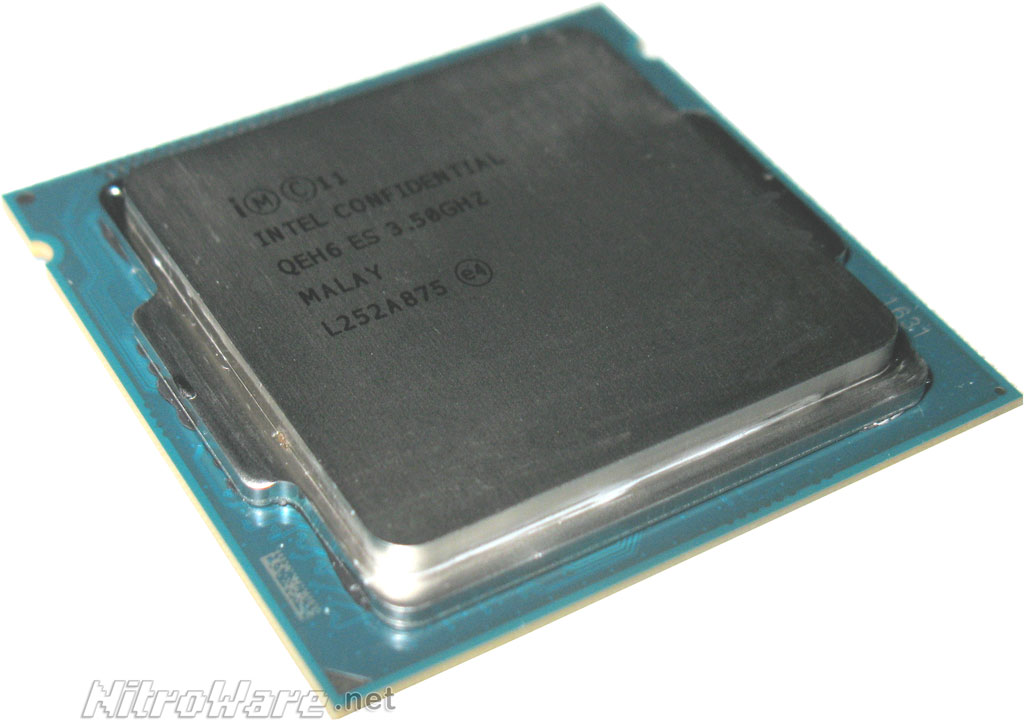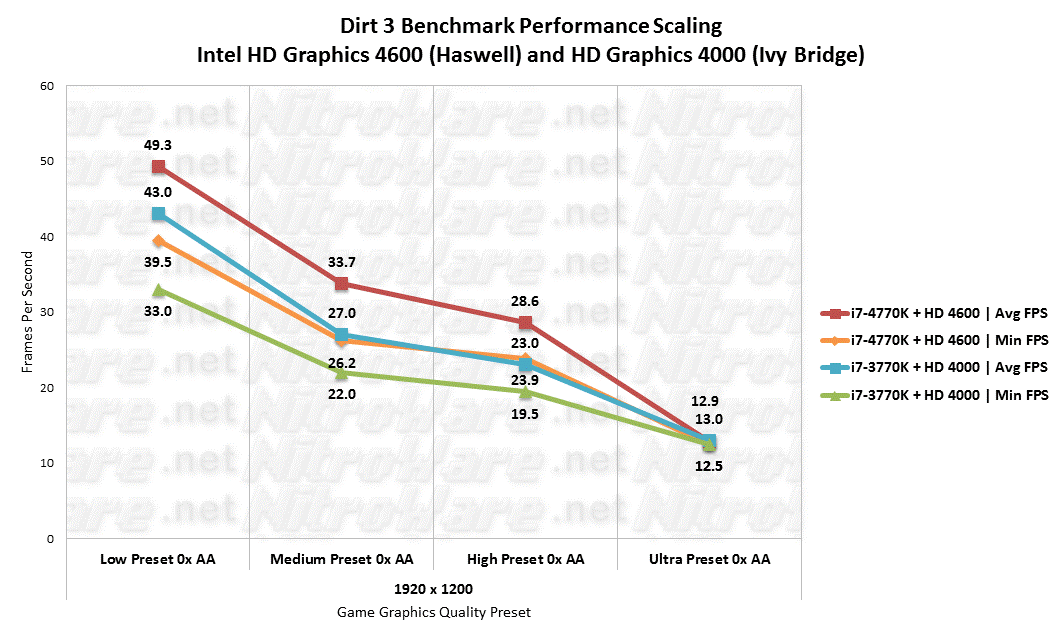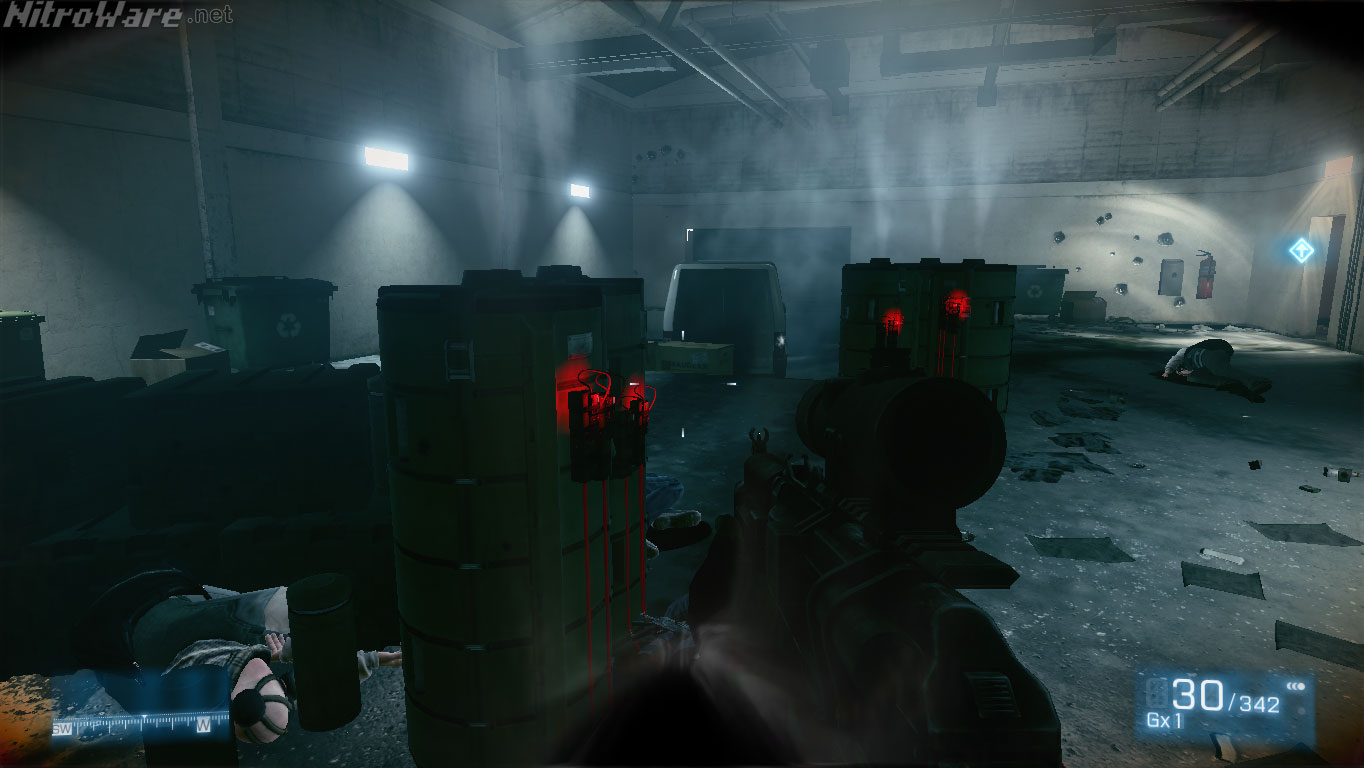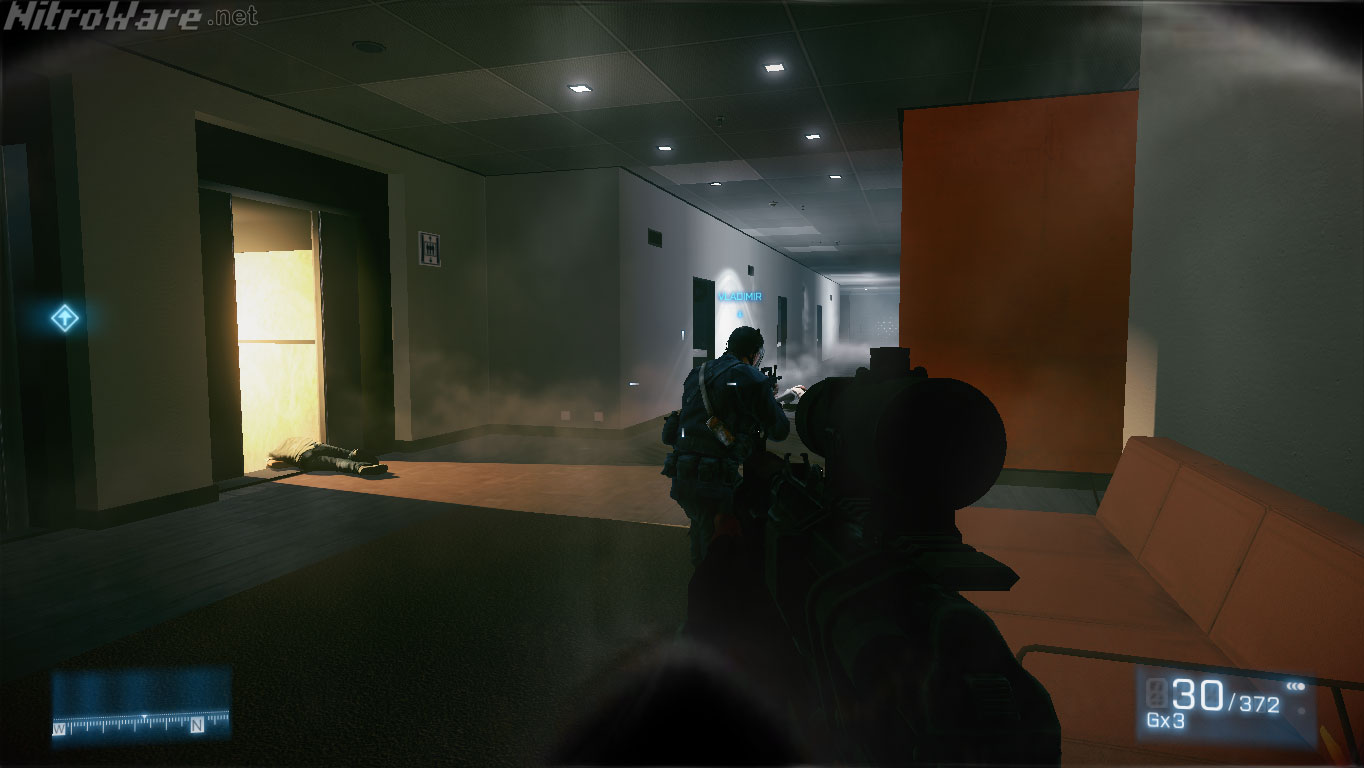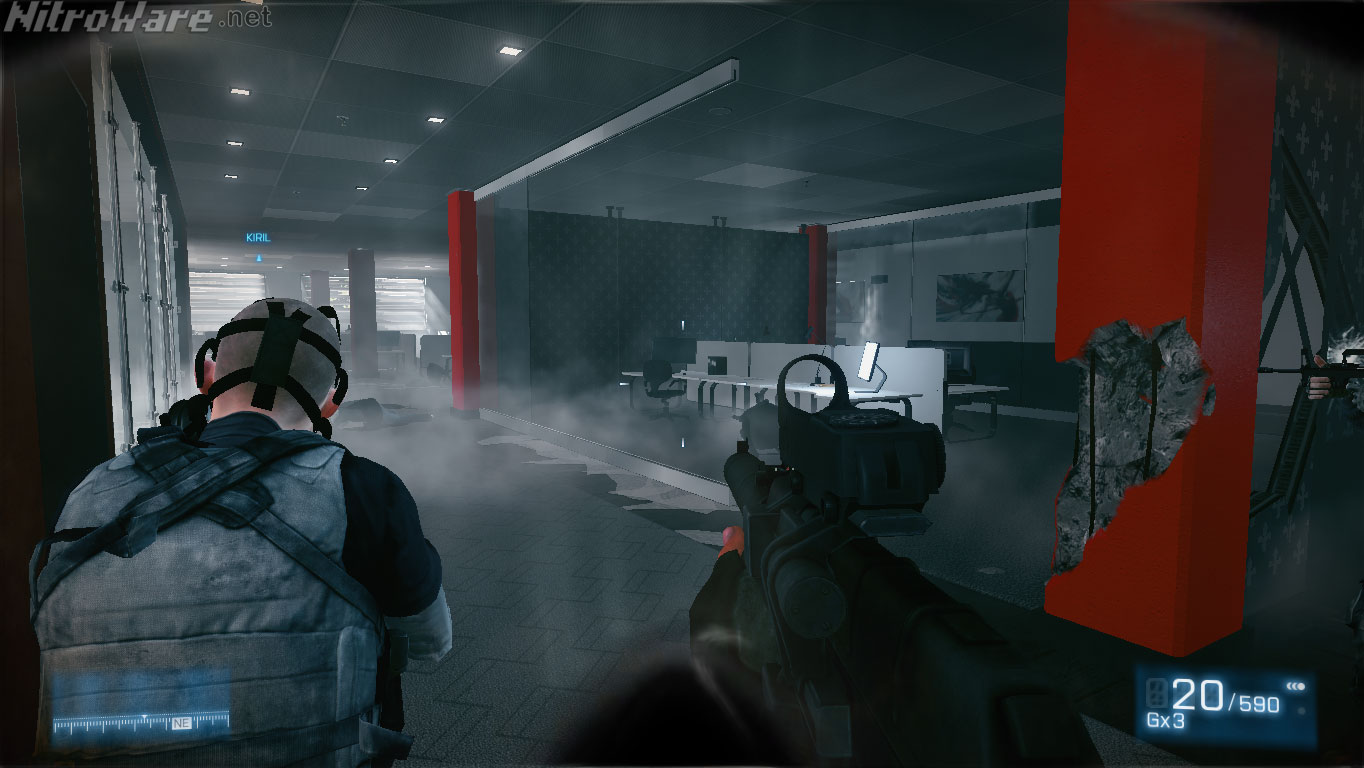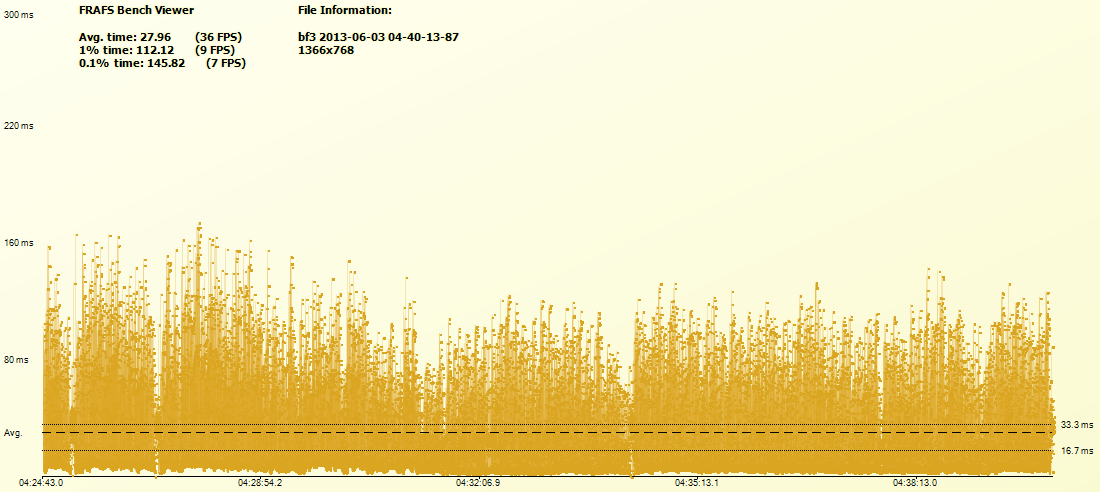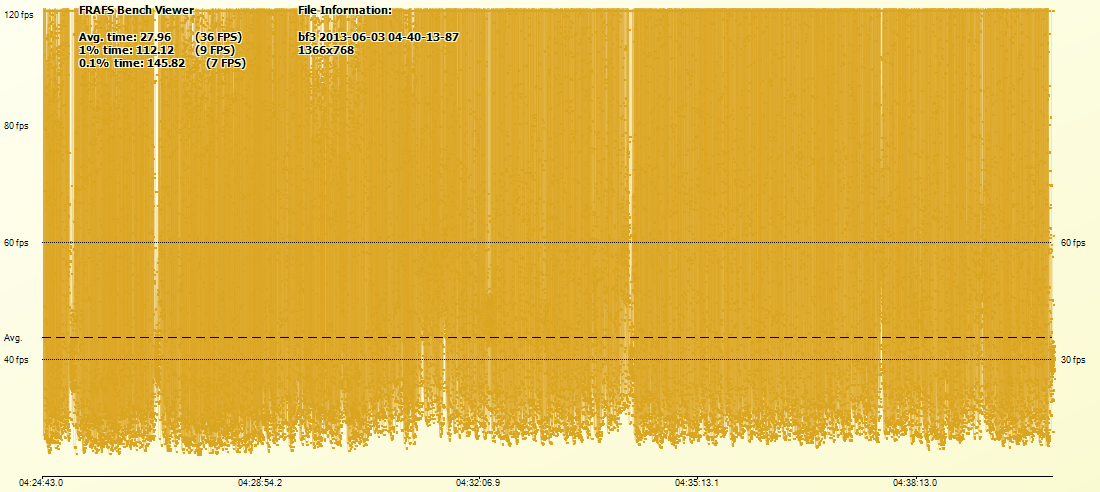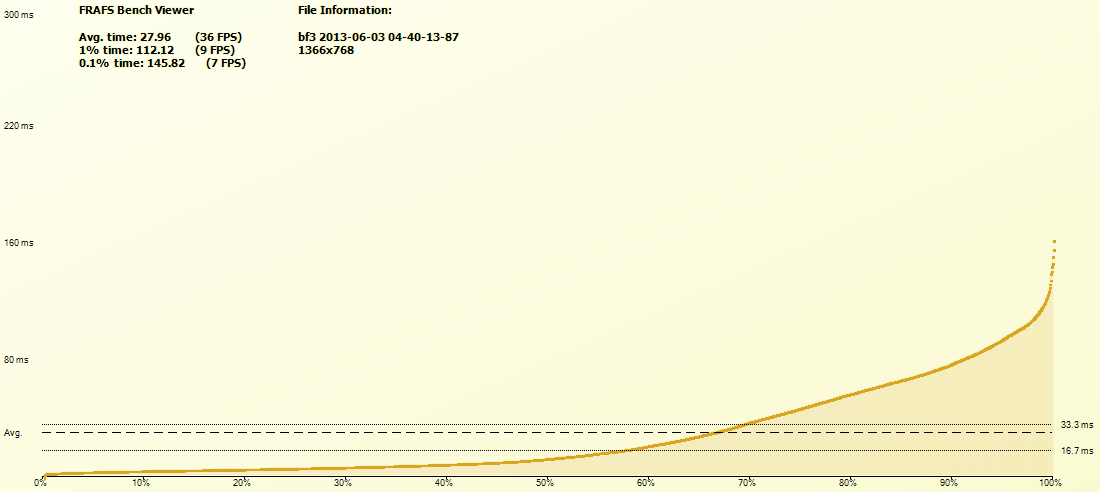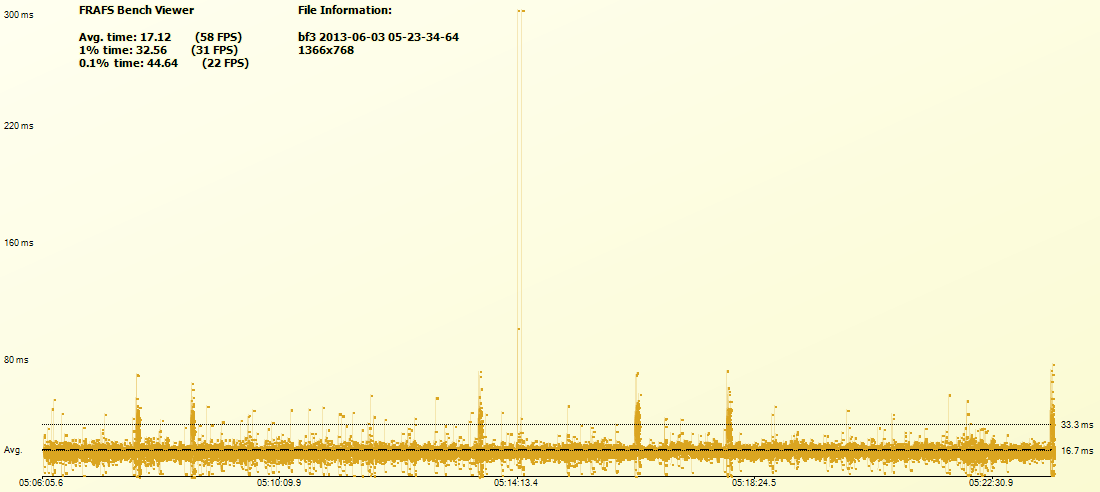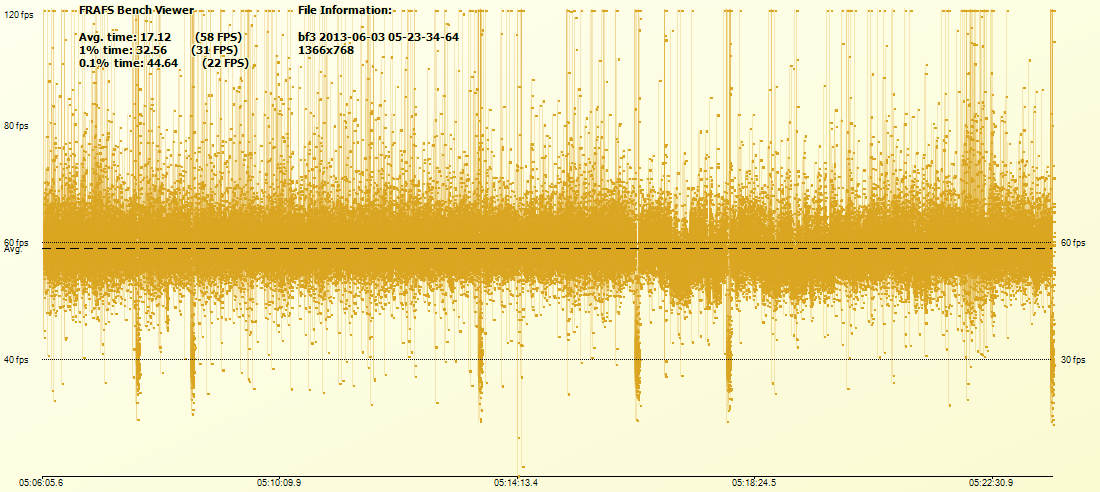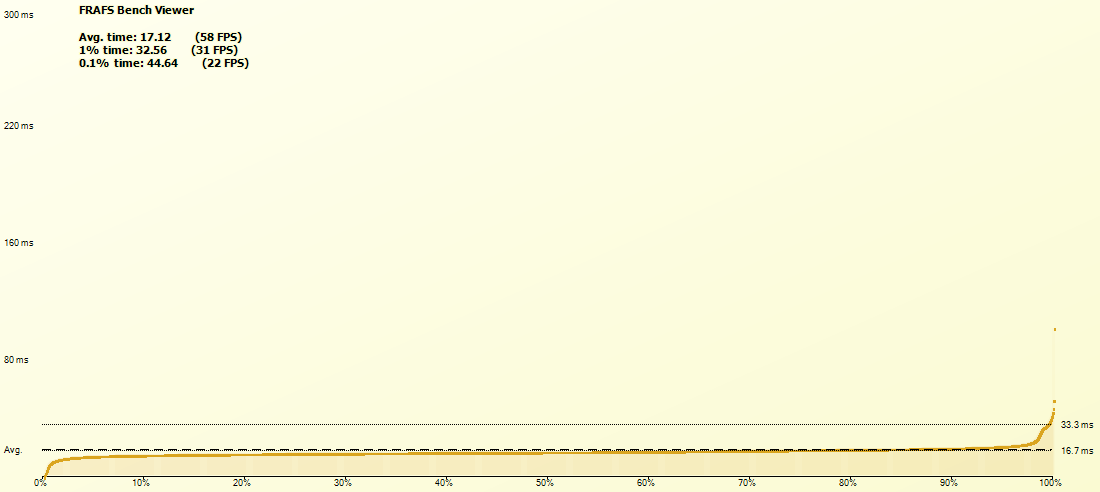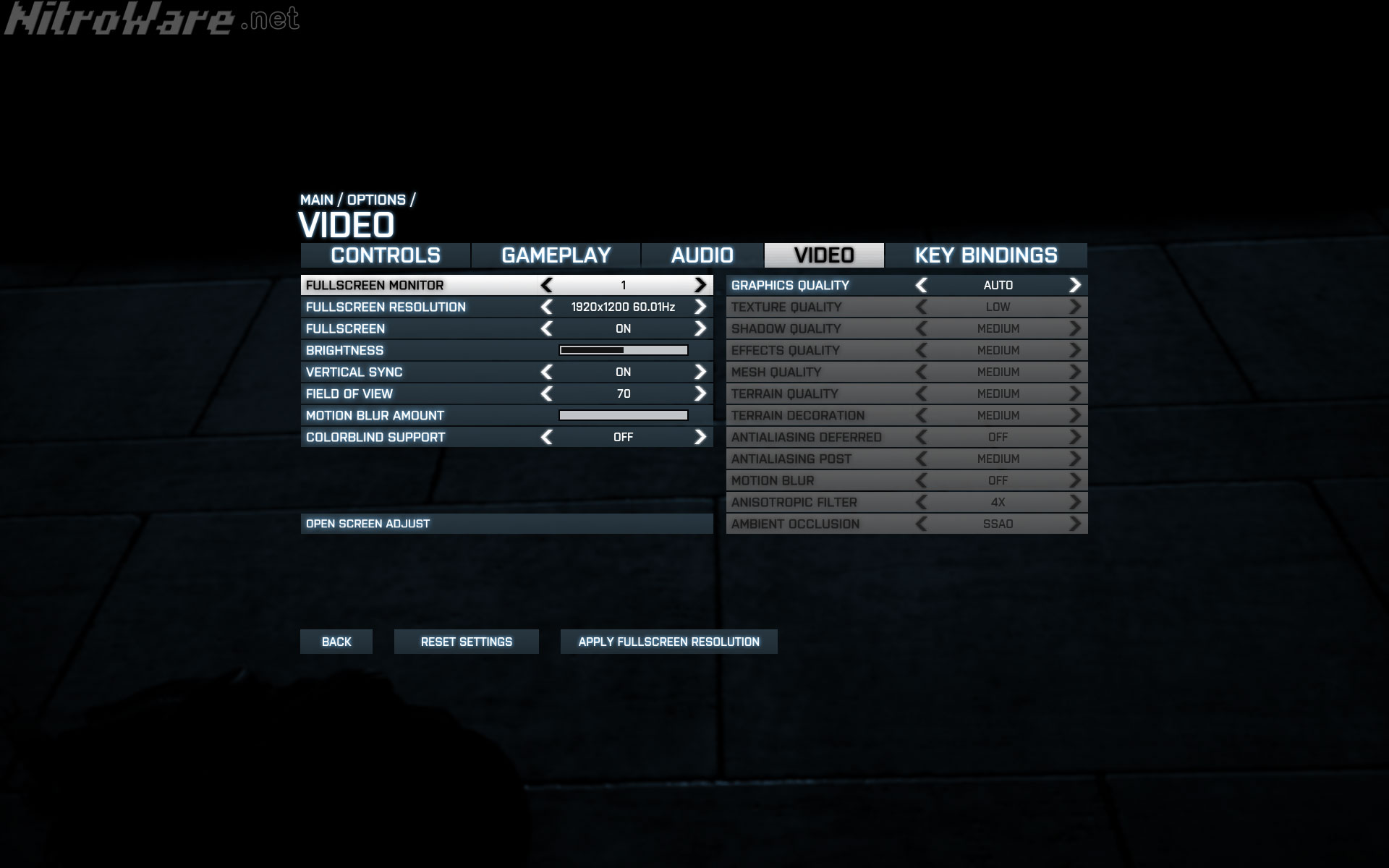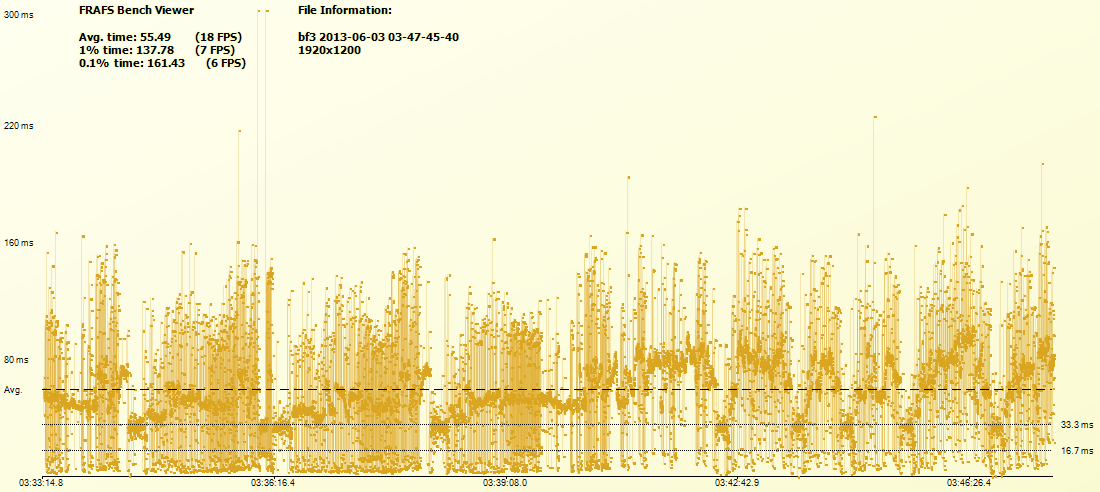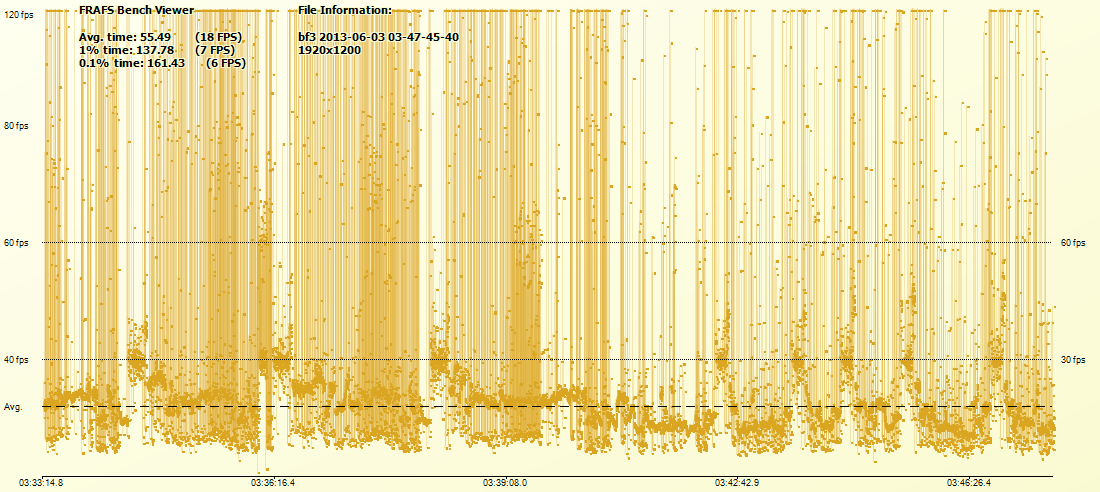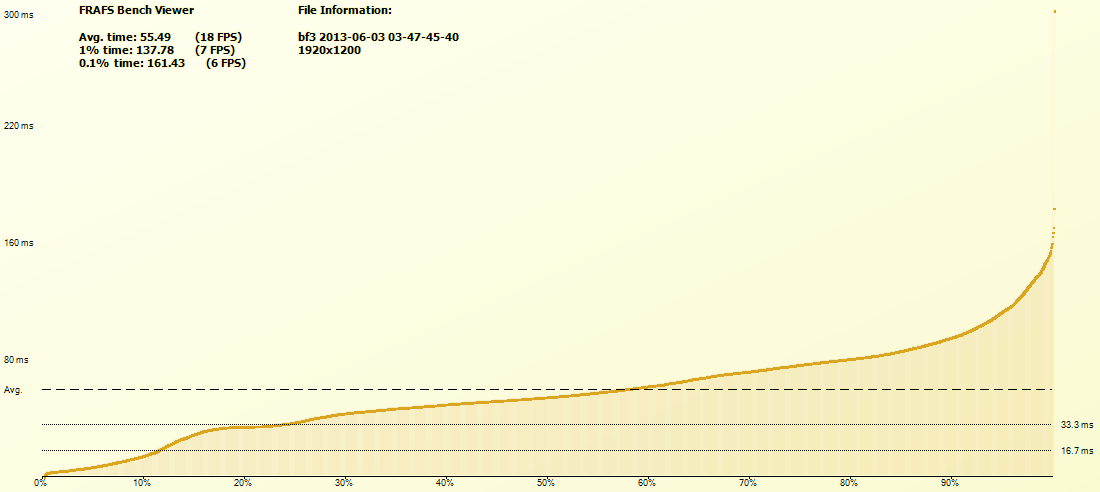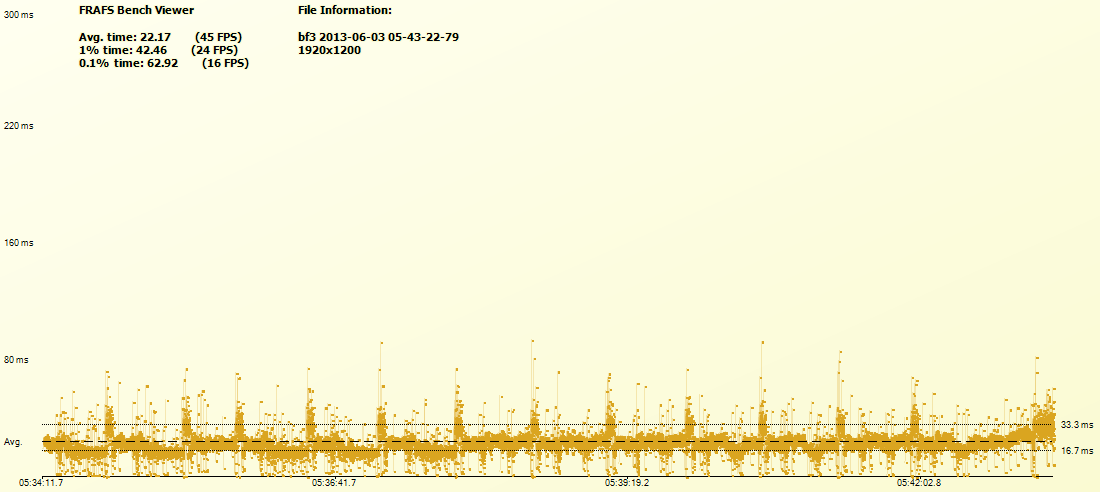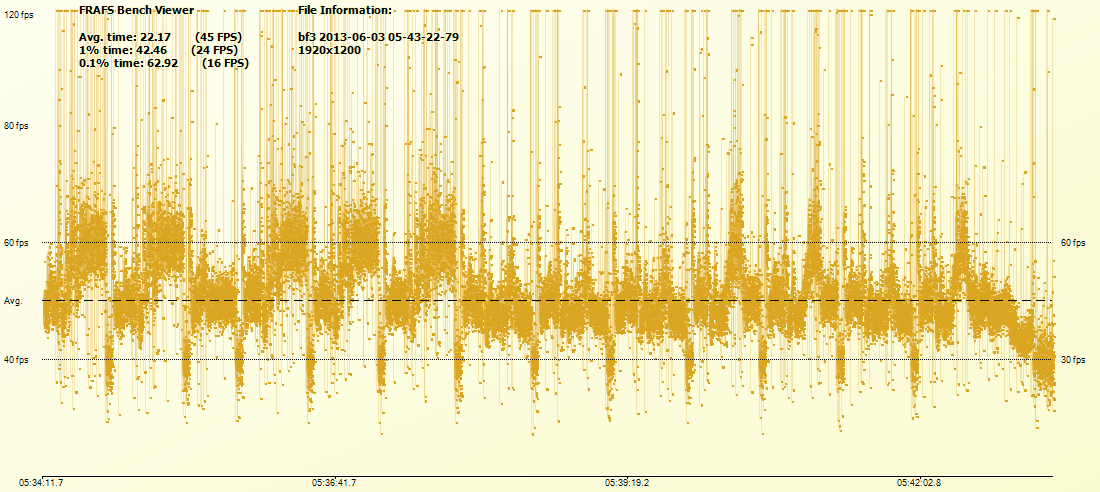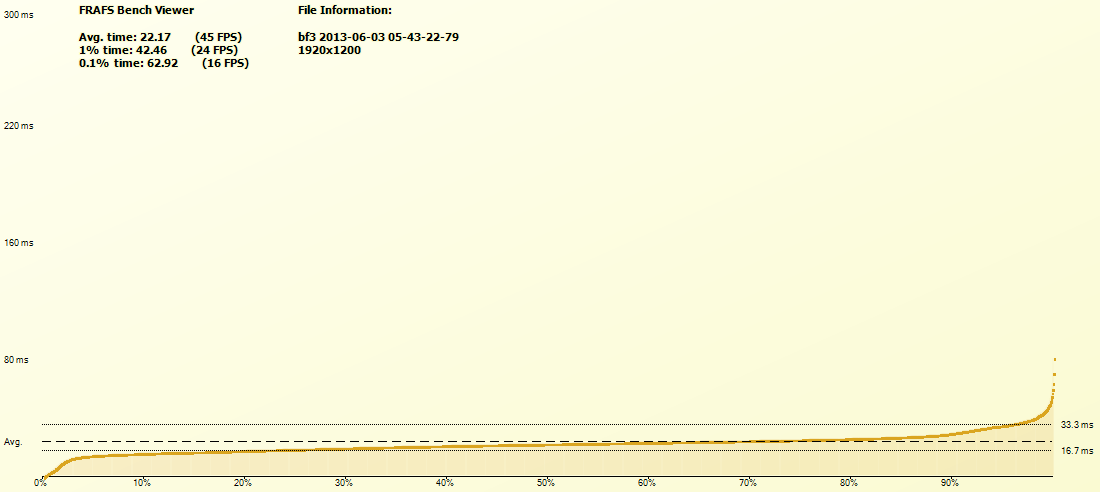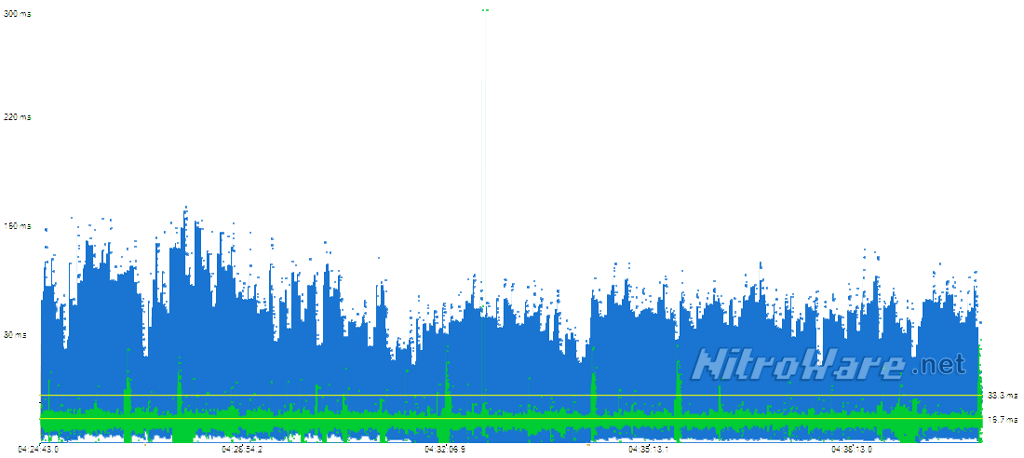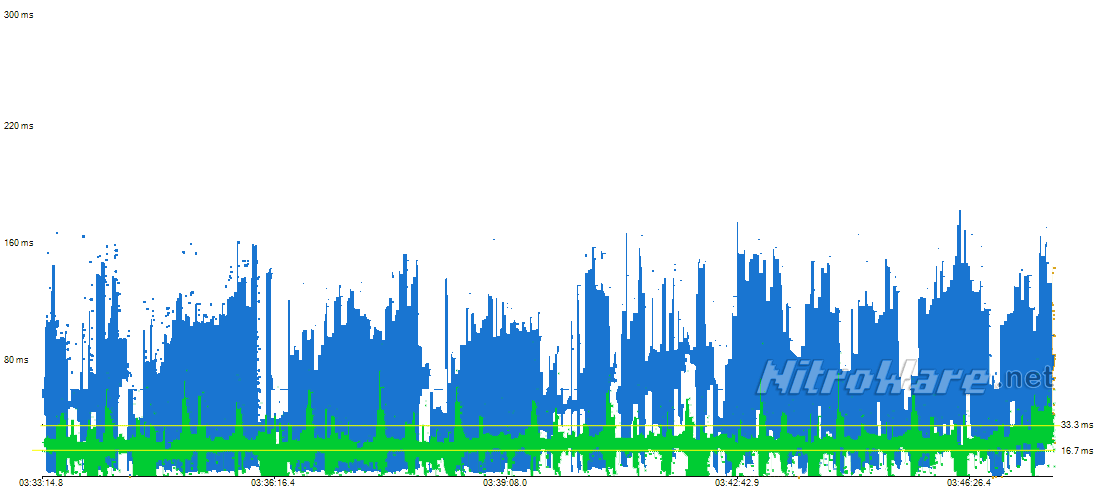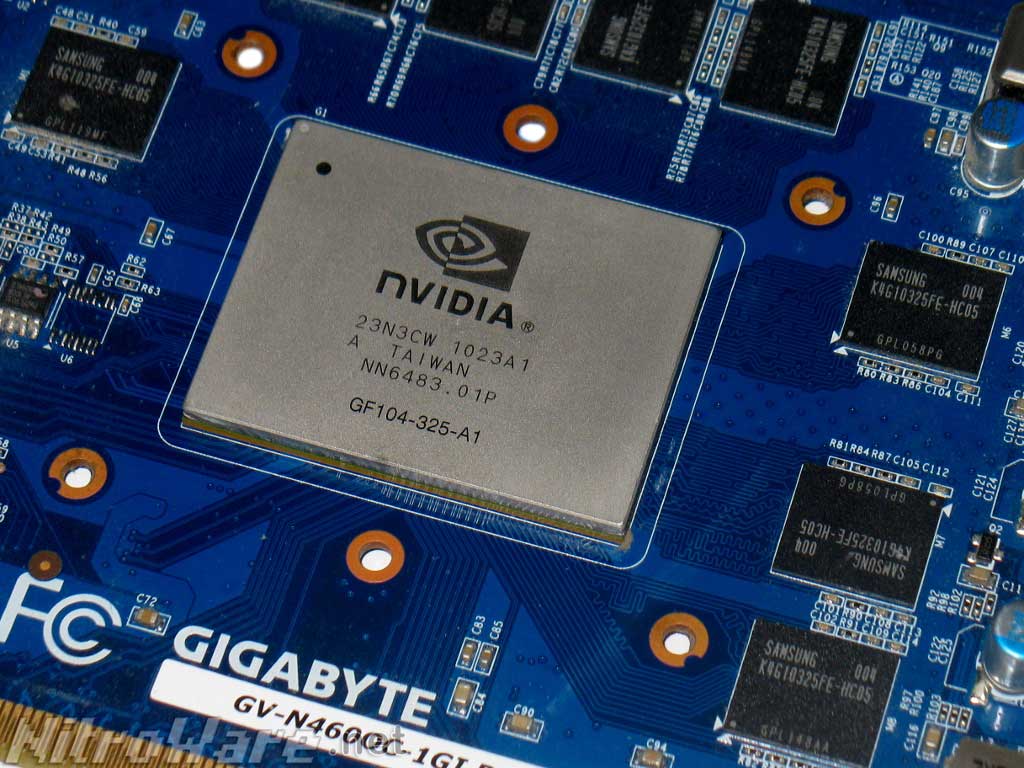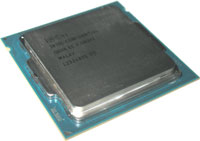 In the first of our Haswell review series, we covered the worst-case performance of the much-improved Intel HD Graphics by testing it at max resolution and details. However, these scenarios are not the ideal conditions for the design and Intel’s fourth Gen HDGPU runs much better at moderate settings such as 720p.
In the first of our Haswell review series, we covered the worst-case performance of the much-improved Intel HD Graphics by testing it at max resolution and details. However, these scenarios are not the ideal conditions for the design and Intel’s fourth Gen HDGPU runs much better at moderate settings such as 720p.
In this edition, we have tested Intel’s HD Graphics 4600 at several realistic and best case game settings with just three very popular titles, Battlefield 3, Bioshock Infinite and DIRT 3. Given Battlefield 3’s popularity, we even dive down to the individual frame level to show the level of smoothness of reported frame rates for this game with Intel and NVIDIA graphics. Battlefield 3 running on Intel HD 4600 had an acceptable frame rate but was not smooth on automatic detail settings.
Test Specifications and Methodology
The aim of this review is to show real world and near real world performance of the mid-range Intel HD Graphics 4600 GPU,code named 'GT2' built into high end desktop Haswell parts, with similar tech built into many Haswell laptops.
We have listed our benchmarks in order of relevance to real world game play.
We could have setup a replicable test case for Battlefield 3 but this does not demonstrate real-world game play for one of the most popular first person shooters.
We used an older discrete NVIDIA GeForce GTX 460 GPU to demonstrate technology leaps over generations and years, as well as to show that there always will be a need for performance discrete graphics. Throwing raw power through memory bandwidth, clock speed and compute cores always wins.Even Intel knew this when they tried to develop Larrabee for consumer graphics and demonstrated this consecutively with Ivy Bridge and Haswell's integrated graphics, by increasing the number of execution units and clock speeds.
A caveat of our approach is hardware vendors have optimised their device drivers and the game code itself for these few titles. Our previous Haswell review used a gamut of tests.
This is somewhat the point really, it is ideal to have a hardware vendor optimise for independent software vendors. The end user receives a better experience in the end but analysts must be careful of how they quantify these experiences.
|
Platform |
3rd Gen Core ‘Ivy Bridge’ |
4th gen Core ‘Haswell’ |
|---|---|---|
|
CPU |
Core i7-3770K (engineering sample) |
Core I7-4770K (engineering sample) |
|
CPU Cooling |
Retail/Stock heat sink/Fan |
Cooler Master Hyper TX3 heat pipe heat sink/fan |
|
Mainboard |
Intel DZ87KLT-75K “Kinsley” (Pre-Production) KLZ8711D.86A.0334.2013.05.08.1817 (Pre-Production) |
ASUS P8Z77-V Pro 2002 BIOS |
|
Memory |
Corsair Vengeance 2400 C10 8GB |
|
|
Integrated Graphics |
Intel HD Graphics 4000 with Driver 9.18.10.3071 |
Intel HD Graphics 4600 with Driver 9.18.10.3071 |
|
Add in Graphics |
Gigabyte NVIDIA GTX460OC 1GB with GeForce Driver 314.22 |
|
|
Chassis |
Corsair Vengeance C70 (three factory fitted fans) |
|
|
Power |
FSP AU-750M 750W 80GOLD |
|
|
Storage |
Kingston HyperX 120GB SSD |
|
|
OS |
Windows 7 Ultimate SP1 Patched June 2013 |
|
|
Display |
Dell Ultra Sharp U2412M 24” LCD 1920x1200 |
|
Bioshock Infinite Benchmark Performance
Bioshock is part of AMD”s Never Settle Game bundle program as well as their Gaming Evolved Optimisation and developer relations program. As such any title under this banner is usually highly polished with some shiny graphics eye candy added in to showcase the latest in hardware with innovative uses of DirectX 11 such as 3D effect, lighting and Physics.
Since it is also a relatively new and highly acclaimed title and it is based on the mature Unreal Engine 3, Intel have also been discussing how well the title runs on 4th generation Core CPUs with the Iris Pro graphics and their driver will have been optimised for Unreal Engine 3 and Bioshock itself.
The benchmark itself is not even that great. It takes some scenes from the game and flies the camera through them with the minimal of AI. A separate benchmark script is provided with the game with the ability to choose graphic pre-sets for the run.
We tested Bioshock by running the benchmark at different resolutions and details, taking the results and presenting them as-is on a frame by frame basis (showing frame times and smoothness) and a summary chart showing the total minimum, average and maximum frame rate for every test. The latter is a visual representation of how performance scales between Intel graphics, NVIDIA graphics and the different generations of Intel Architecture. 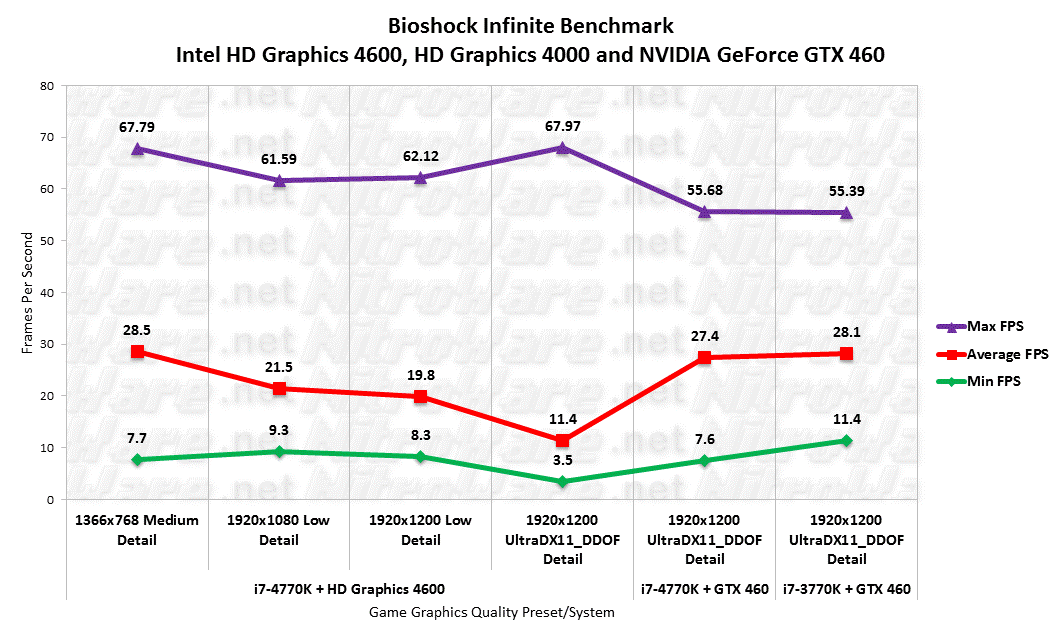

The bigger difference between our minimum, average and max frame rates, the worse the overall experience is. If we consider average frame rates only, 1366x768 resolution is the only one that passes the ‘playable average frame rate’ test with 28 frames per second. This corresponds with some Intel’s messaging of 720p.
Let us compare 1920x1200 with Ultra+ Detail and no Anti-Aliasing using the HD Graphics 4600 GPU and a now three year old mid-range performance gaming GPU, NVIDIA’s GTX460.
We presume the GPU has a worse max frame rate due to the different graphics driver and graphics/video memory architecture versus the solutions, however the GPU is 2.5x faster than the integrated GPU. Given the size, cost and power consumption of the GPU that’s not bad. Lowering the settings should improve things.
We did no test every combination as this would be complex to analyse and we were pressed for time. The above chart concisely shows the entire gamut of performance scaling top to bottom.
Ivy bridge is faster than Haswell with the same components because ASUStek are masters at optimising their PCB design and BIOS settings. Additionally, Haswell’s design makes some compromises for lower power and the software does not take advantage of the new instructions in haswell. Some design changes in the CPU do have a tendency to reduce performance in some circumstances additionally. Although ‘only’ four frames difference, Ivy Bridge is actually 1.5 times faster at minimum frame rate!
We have not been able to test Haswell after our brief evaluation under embargo before launch so we have not been able to re-test our scenarios to see if updated drivers help.
As we explained, Bioshock’s built in benchmark is not the ideal test case so let us try something else that is closer to home.
DIRT 3 Benchmark Performance
Like Bioshock, Dirt 3 was also a member of AMD bundling and Gaming Evolved. However over time, NVIDIA improved their drivers to better quality and performance with the game.
Testing DIRT3 is straightforward. The built-in benchmark runs a race at the Aspen track with Random Opponent AI. The finishing over and winner will vary benchmark to benchmark. As with a typical benchmark, we tested with V-Sync disabled however, for this scenario, we did not enable anti-aliasing to improve performance.
Infrequently, the AI driving the player or opponent cars will crash out, stalling the benchmark. The leader board varies race to race.
The average and minimum frame rate reported which we plot for each of the detail pre-sets we tested, giving an overall picture how the game performance scales depending on the game detail, resolution and hardware used. 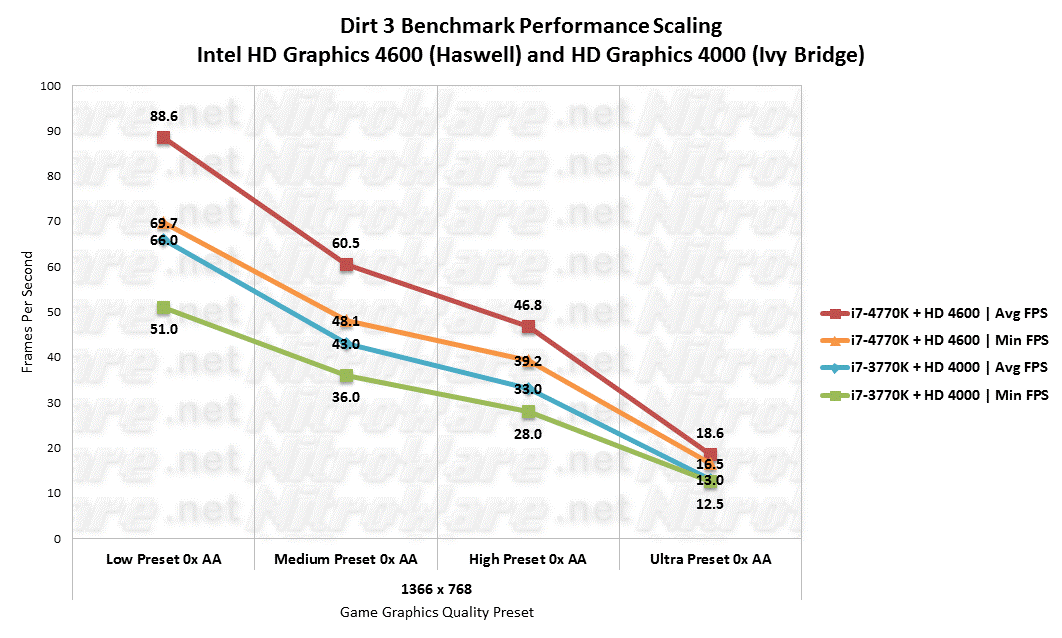
Fortunately, we have a more complete performance picture for Dirt3 as we completed some of the testing for a project prior to Haswell.
Codemasters titles run better on Intel than Bioshock due to their commitment to optimise for COdemasers’s popular racing titles built on the EGO engine.
Ideally, we want to see a linear plot between the lowest resolution/detail combination and the highest. From an ideal plot, we can infer there are no bugs or bottlenecks in the graphics hardware or software that it can scale well.
Scaling wise both Intel HD4000 and 4600 plot and scale similarly across tests. Gamers can enjoy smooth playable frame rates art 13x7 High preset but not Ultra
In comparison, HD4600’s minimum frame rate is higher than HD4000’s average frame rate! Dirt 3 is internal metering does not report maximum frame rates and for consistency we do not want to use fraps or an external solution for this title.
While performance increasing by one tier is impressive comparing the generations of Intel graphics, their basic architecture, the building blocks of the chips logic are the same so performance for the GT2 parts can be attributed to clock speeds, optimisations and the increased number of Execution Units (or ‘cores’)
Cranking up a few notches to 1920x1200 resolutions, Our numbers at low detail are more compressed and despite sharing the same driver version, we can see the effect of the overall platform on the numbers. Ivy Bridge beats Haswell, however overall, Haswell’s minimum frame rate manages to beat of Ivy Bridges Minimum frame rate but there is not much in it.
1920x1200 Medium preset seems the best balance of quality and performance. 1080p gamers should have higher numbers naturally but 1080p to 1200p is not a significant reduction in pixels, both screen resolutions are in the 2.x MP range. 2.07 MP versus 2.3MP or only an increase of 11%.
GRID 2
Intel went to Codemasters for DIRT2 (DIRT3 does not have the Intel Logo), F1 2012, and GRID 2.
F1 2012 and Intel have an infamous relationship
A free GRID 2 t-shirt and game coupon was bundled with the fourth gen core i7-4770K processor in selected markets.
At the Intel 4th Gen Core Launch in Sydney, Australia on 12 June 2013, Gregory Bryant Vice President, Sales and Marketing Group General Manager, Intel Asia-Pacific Region hosts a demo of GRID 2's built-in benchmark running on an Iris Pro equipped laptop.
GRID 2's settings were 1366x768, Ultra Preset Details and CMAA enabled. LG TV (3840x2160) were used for the launch keynote demonstrations.
See Part1 of our Haswell review series covers worst-case performance with both NVIDIA GeForce and Intel HD Graphics. http://www.nitroware.net/reviews/281-haswell1
I have run Codemasters benchmarks enough times that I vouch for the Intel demo as presented. Not only was it run in windowed mode, but the random AI element is evident in the demo.
Battlefield 3 Frame-Analysis and Gameplay Performance at 1366x768
To test BF3, we used real gameplay with V-Sync enabled and automatic details selected in-game and played through the game progressively for 15 minute single player sessions which were recorded by FRAPS.
Fraps captures the time taken for each frame (at the highest lowest measurable point in the graphics pipeline), as well as the total minimum, average and maximum frame rate.
For ease of comparison, we tested at only 1366x768 and 1920x1200 for both Intel HD Graphics 4600 and NVIDIA GTX460 Graphics; with automatic details selected in game.
Our measurements cover the reported frame rate as monitored by the GPU and the software, not the actual observed frame rate that the user sees on the monitor. Our measurements include loading screens and save-game reloads.
We did not ‘benchmark’ Battlefield 3 per se, but we recorded the performance during gameplay and our actual progression through the single player campaign in blocks of appropriately 15 minutes. We feel this is an accurate representation of real world gameplay and experience of this popular title on Intel.
By not repeating the same exact test case on Integrated and DIscrete graphics, we replicate the scenario where an end user will upgrade their GPU during the progression of their favorite game and notice the changes. Some users will of course, replay the same level to get a AB comparison but depending on the game, different game levels can either present similar performance or varying performance.
Sites such as PC Perspective, Tech-Report and other Tier 1 & 2 media who were sampled by NVIDIA have the necessary specific capture card and guidance to perform independent measurements of frame rates (‘frame rating’) at the display output stage.
While we do not have this equipment, we constantly strive to adopt industry best practise. NitroWare.net is 100% owned, operated and hosted in Australia and as such Australia Specialist Tech media do not have the same in-depth access to hardware vendors other regions have. ‘Frame rating’ requires several thousand to tens of thousands of dollars worth of display and storage hardware to store terabytes of game captures as video files, plus the system horsepower to analyse these video streams.
Looking 'inside the second', a term coined by The Tech-Report's Scott Wasson is the next best thing to frame rating. What this means is our Battlefield 3 charts show every frame presented to the graphics hardware for display.
Battlefield 3 : Operation Guillotine: Secure the Bank with Intel HD Graphics
In-Game Screenshots on Intel HD 4600 at ‘auto’ details, 1366x768
This first chart plots frame-times over the length of game-play
A frame-time is a slice of frames-per-second. For example, 60 Frames per Second gives us 16.7 milliseconds to each frame, and 30FPS gives us 33.3ms per frame. Consistent frame times give us smooth motion.
Remember, FRAPS only reports the time it takes the software to generate the frame, not the total time the GPU takes to process and output the frame.
Our wide plot is all over the place and reflects the slow, stuttery gameplay we experienced on Intel Graphics. We desire a narrow and tight plot, bounded within average lines for 30 and 60FPS. The noticeable gaps in the plot are loading screens.
Another representation of the same data set is Instantaneous reported frame rate over time
The rank plots the percentage of which particular frame times make up the entire data set. Again we desire a narrower tighter plot to signify smooth game play, where more frames of similar times take up the majority of the rendered frames.
Mission Comrades with NVIDIA Graphics at 1366x768
Progressing through the game, we switched over to NVIDIA GTX460 graphics for subsequent gameplay and the results speak for themselves.
Our frame times chart is the same scale as our Intel one, notice how tight and smooth the frame time plots are, ideal gameplay and this is only with a 3 year old, 3 generation old GPU.
Our alternate view, shows similar, a relatively narrow frame-rate plot.
A perfect, smooth compliant plot, frame times remain consistent throughout the gameplay session and do not vary.
Battlefield 3 Frame-Analysis and Gameplay Performance at 1920x1200
Operation Guillotine: Secure the Bank with Intel Graphics at 1920x1200
With our 19x12 gameplay plot, our average frames and runt frames are clearer to decipher. The dark clustered and jaggy line comprises the majority of our frames, ranging between 30FPS and 15FPS. All the offshoots are runt frames.
Both our representations show a jaggy/sawtooth average plot, not what we want to see.
Our frame times get worse over time.
Mission Comrades with NVIDIA Graphics at 1920x1200
While a GTX460 1GB does handle 1920x120 and provides good gameplay, newer GPUs offer a 2 or 3x improvement.
At this higher resolution, frame times have more variance but the overall plot is consistent.
Again, Higher Variance with instaneous FPS but at least performance is predictable and repeatable. 1920 x 1200 in general does take around 1GB of memory on a graphics card, so we are pushing things here. However,compare to Intel.
Percentile show a slight decrease in performance over time at 19x12, which consumes more resources than 13x7, with an additional higher percentage of frames outside the average.
Battlefield 3 : 'Inside the Second' Frame Rate analysis overview
Overlaying our plots puts things into perspective. Note that each coloured plot is the a separate section of the same Battlefield mission, not a repeat-run or AB comparison.
Graphically and Visually, it is clear to which graphics solution offers the better gameplay experience.
Verdict
As we demonstrated in our launch review of Haswell, the Intel GPU is vastly improved but so has everything else. For our three key game titles, Dirt, Bioshock and BF3 performed best in that order. We observed Battlefield had heavy stuttering on Intel and our data captures reflect this. Changing to a NVIDIA GEFORCE GTX graphics card improves the situation for Battlefield 3, providing ‘buttery smooth’ gameplay.
Intel is still reliant on driver support for optimal game experience. Legacy titles such as GTA4 simply do not work on this solution due to caveats with the hardware and software.
If you play triple A titles, these will be well supported by AMD, Intel and NVIDIA. For more obscure or older titles, AMD or NVIDIA is required just for compatibility let alone experience and performance.
The integrated GPU on Intel enthusiast parts makes little sense as the 4770K and similar CPU will usually be paired with an add-in discrete enthusiast class GPU. The Integrated graphics cannot even be fully utilised even for OpenCL applications or Quick Sync Video decoding.
On some of the motherboards we tested, a monitor must be connected to the on board video ports to fully wake the iGPU and use it. It is partially functional without this connection.
Intel HD Graphics 4600 and Iris 5000 series graphics make more sense in the notebook context.
Intel requires heavy investment into their graphics software engineering team and developer relations. Infrequent driver releases are not sufficient. They have been hiring and making inroads in this area but the more they catch up, the more AMD and NVIDIA will increase their leadership.
Intel, I applaud you for making a worthwhile integrated graphics solution with the HD4600 but enthusiasts have been down this road before and some have been bitten along the way.
Tech media have said repeatedly Intel needs to pour resources continuously into Developer relations and software development, not just one-time deals for major hardware releases.
Gamers, you can indeed game on Haswell’s HD graphics if you had to. Good luck, you will need it. 